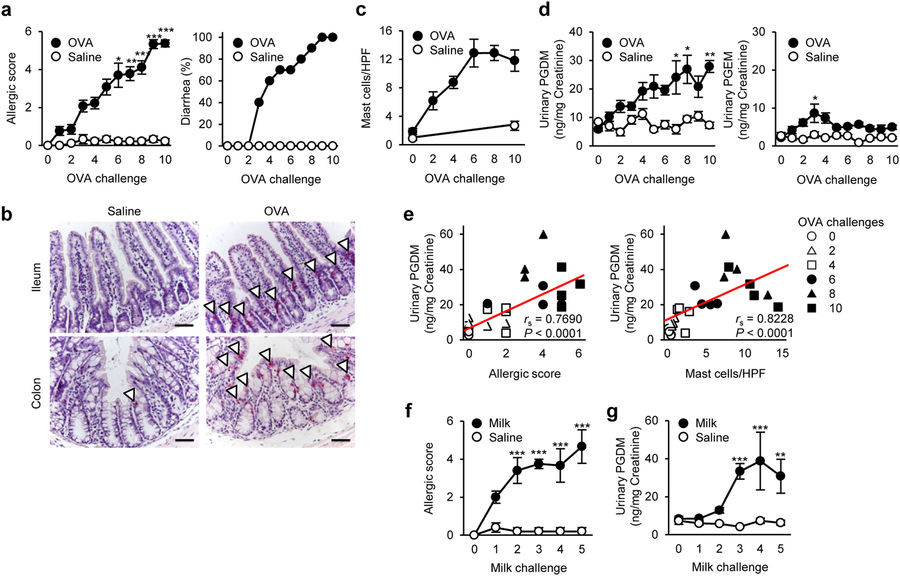尿中のプロスタグランジンD2代謝産物は食物アレルギーの指標である
Prostaglandin D2 metabolite in urine is an index of food allergy
2017年12月15日 Scientific Reports 7 : 17687 doi: 10.1038/s41598-017-17798-w

食物アレルギーは摂取した食物に対する迅速な過敏反応である。その制御には早期診断が効果的であるので、客観的な診断指標の開発が必要である。我々は、メディエーター・リピドミクスを用いて、尿中のプロスタグランジンD2(PGD2)代謝産物であるtetranor-PGDMのレベルが、マウスにおけるアレルギー症状の重症度および腸のマスト細胞過形成を反映することを見いだした。卵白アルブミンを感作したマウスに卵白アルブミンを繰り返し経口投与すると、アレルギー症状が増強された。特に、アレルギーマウスは腸のマスト細胞数の増加を示した。このマスト細胞はH-PGDS(hematopoietic PGD synthase)を高発現していた。アレルギー症状が悪化すると、尿中tetranor-PGDMのレベルは上昇した。このような症状はマスト細胞を不活化する薬剤あるいは抗炎症性ステロイドの投与により減弱し、tetranor-PGDMの尿中レベルが低下した。尿中tetranor-PGDMのレベルは、大腸炎、喘息、あるいはアレルギー性皮膚炎のマウスモデルでの疾患重症度とは相関しなかった。そのうえ、tetranor-PGDMの尿中レベルは、健康な試験参加者や、喘息、アレルギー性鼻炎、アトピー性皮膚炎などの他の種類のアレルギー性疾患の患者よりも、食物アレルギーの患者で有意に高いことが示された。これらの知見から、尿中tetranor-PGDMはマウスおよびヒトの両方における食物アレルギーの有用な診断指標であると考えられる。
Corresponding Author
Food allergy is immediate hypersensitive reactions to ingested foods. Since early diagnosis is effective for disease control, development of an objective diagnostic index is required. Using mediator-lipidomics, we found that levels of the urinary prostaglandin D2 (PGD2) metabolite, tetranor-PGDM, reflected the severity of the allergic symptoms and intestinal mast cell hyperplasia in mice. Repeated oral challenges with ovalbumin promoted allergic symptoms in sensitized mice. Particularly, the allergic mice presented with increased numbers of intestinal mast cells, which strongly expressed hematopoietic PGD synthase (H-PGDS). The levels of urinary tetranor-PGDM increased as the disease progressed. Treatment with a mast cell inactivator or an anti-inflammatory steroid attenuated these symptoms and decreased the tetranor-PGDM urinary levels. The levels of urinary tetranor-PGDM did not correlate with the disease severity in murine models of colitis, asthma, or allergic dermatitis. Furthermore, we have shown that urinary levels of tetranor-PGDM were significantly higher in patients with food allergy than those in healthy volunteers and patients with other types of allergic diseases such as asthma, allergic rhinitis, and atopic dermatitis. These findings suggest that urinary tetranor-PGDM is a useful diagnostic index of food allergy in both mice and humans.

